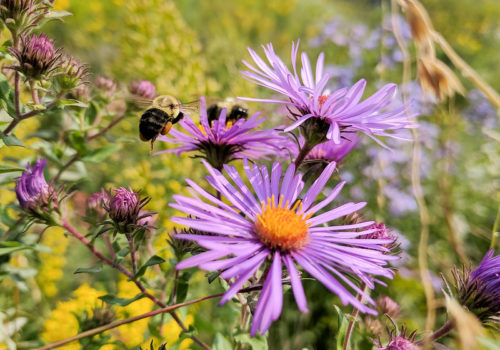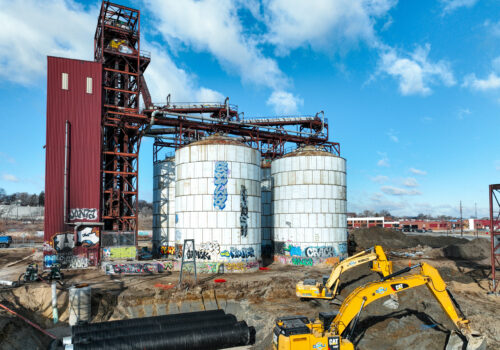News / May 04, 2021
Habitat at Home: Planting for Pollinators and Starting Small


Protecting water quality and habitat are tightly connected, and each person can play a role in fixing the vexing problems we’re facing on both fronts. Many of the issues stem from the vast land use changes that began with European colonization and westward expansion. When considering the extent of water pollution and habitat loss, it is important for us to take actions to restore and revamp our yards, open spaces and ecosystems with native plant communities of the still-to-this-day and ancestral lands of the Dakota people.
In this blog post, we will cover why planting for water and habitat is important, things to consider and actions to take before planting, and how to choose plants along with some suggestions.
Native Plants, Water, and Habitat
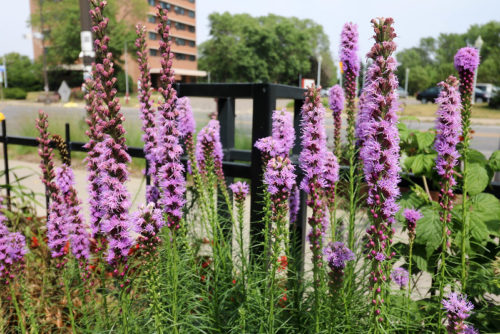
When it rains in the urban environment, the amount of water that runs off the surface of the land is considerably higher than that of a native plant landscape (such as the tall-grass prairies that once covered vast swaths of Minnesota). With this increased urban water runoff, our waterways experience considerable pollution impacts. Rain and melting snow pick up things like trash, soil, leaves, and other pollutants and carry them to rivers and lakes without treatment.
Tied to this issue of impervious surfaces (roads, bridges, buildings, even compacted soil) is a severe and significant loss of habitat. Specifically, native plant communities around the Twin Cities area have declined to a fraction of what was present before. Native plants and the ecosystems they formed over millennia are home to countless organisms that coevolved with the plants overtime. Most insect herbivores (insects that consume parts of plants like pollen, nectar, and leaves and turn them into proteins) coevolved with a specific host plant, and without those plants, we lose the insects that support insect-eating birds and other animals further up the food chain. An entomologist with the University of Connecticut estimates that the planet is losing 1-2 percent of all insects each year due to human activities.
In order to protect water and habitat, it’s important for us to plant more native plants. Native plants are adapted to growing in our local climate, take in relatively large amounts of water, require little to no watering (once established), and provide habitat for insects, birds, mammals, and other wildlife that rely on them for all stages of life. Keeping native plant and insect populations intact is crucial for supporting whole ecosystems, and necessary for keeping us and waters healthy. Adding native plants at home can be a beautiful way to help improve our environment, even when starting small.
Choosing to Plant Native Species
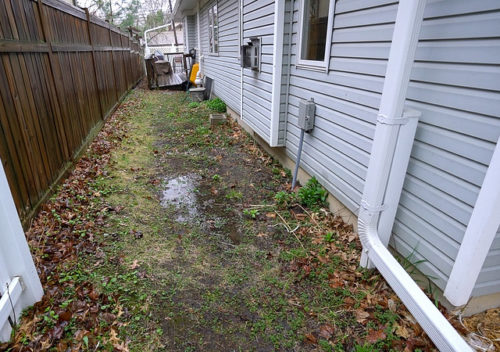
Residential yards with large rain gardens or full native landscapes are wonderful, but they can also feel daunting to those unfamiliar with plants, shrubs and trees, or who don’t want a complete transformation project. Fortunately, even a small patch of native plants in your yard can provide a meaningful source of habitat.
When considering where to put in native plants, it’s good to consider what presently is in your yard or garden. Do you have problem spots where turf just doesn’t seem to grow? Do you have wet spots that remain wet for long periods of time after it rains? What about a dripline or an eroding area? All of these conditions present options for using native plants, which are well suited to establishment when compared to cultivated species and turfgrass. Choosing a location that helps fix a problem might be the best first step.
One good spot to plant native species can be at the end of a gutter downspout. This is a great way to capture the water from your roof and let it soak into your lawn through these deep-rooted plants (though slowing down the water with rocks when it reaches your yard can help prevent wash-outs of your plants).
Another option is to simply choose a spot where you’d like to replace turfgrass. While turf does take in some water, it’s capacity for letting water soak in is very low. Choosing to convert even a small patch of turfgrass into native plants is a great start for both managing water and creating habitat.
A Few Considerations
Before you get planting, it’s important to consider what already exists in your yard. It can be helpful to draw out where things are in your yard (trees, landscaping, existing plants). This can help you think about location.
Other things to consider include the availability of light and water. Light is an important consideration when choosing the right plants; does the area you want to plant have full sun, partial sun/shade, or full shade? Observing where the sunlight falls throughout the day can be simple way of determining what can survive in that spot. (Keep in mind that you’ll need to factor in any trees that provide shade after they leaf out in mid-spring.) As for water, it’s important to consider how you can water the planting. Not everyone has a hose that can reach the area in times of drought, so you may be hauling buckets in that case.
Lastly, considering your soils is a great thing to do before planting. One important step is doing a percolation test, which is a way to see how water soaks into your yard. If your percolation test demonstrates that water doesn’t soak in, it may be time to amend your soils with compost or topsoil to improve infiltration of water into the soil. You can always take a soil sample and send it to the University of Minnesota’s lab, which will tell you the composition of your soil (clay, loam, sand, or urban fill). In some cases, you may discover that you’ve got a bit more digging to do to fix those soils, but as long as you’re not going really large with your planting, it should be viable for a do-it-yourself fix.
Before you dig, always call Gopher State One Call to have them map out utilities that may be buried underground.
Choosing Plants, Shrubs and Trees
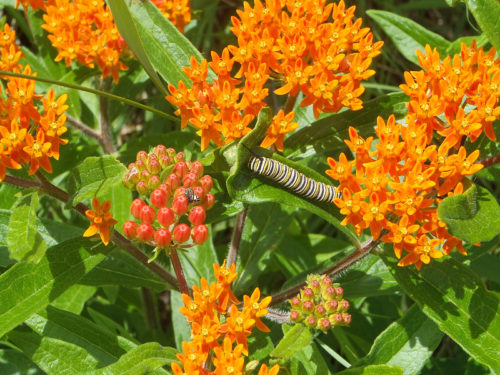
Ultimately, making a choice on what you’d like to plant is where things will come together. Keeping in mind the soils, light, and water as you choose your plant material is really important, so make sure to check the labels to ensure that the plants are suited to your planting location. Also, these tags will tell you other things, like whether they are native, whether they have been treated with pesticides (avoid neonicotinoids—they harm insects), and appropriate spacing when planting.
There are a number of resources out there to help you choose plants that suit your goals, and here are a few ideas:
- Visit local natural areas to see what catches your eye, especially nature centers or places that have interpretive signage talking about native plant species.
- Connect with plants sales in the local area, as there are a number of these each spring in the Twin Cities metro area. (Note: Some of these have been disrupted due to COVID-19.)
- Consult with growers and nurseries that specialize in native plants, as they can help you choose what suits your needs and wants (we have a list on our website).
- Check out the BlueThumb plant guide, which lets you choose by a number of different things like lights, soils, and flower color.
- Ask MWMO outreach staff or others who work in the field, as there are many local professionals with plenty of experience in choosing plants!
Native Plants, Shrubs and a Tree for Habitat
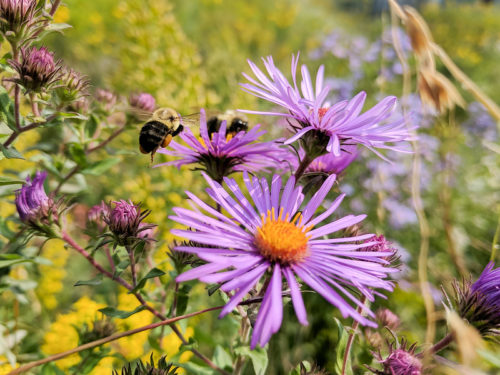
To help steer you in a direction without providing too much information, here is a short list of native plants suggested that are pretty hardy and resilient, and will certainly provide habitat benefits:
- Milkweeds: Common milkweed, butterfly weed, swamp milkweed, and whorled milkweed are all great choices that are crucial for monarch butterfly populations (monarch larvae/caterpillars feed exclusively on milkweed leaves), and are beneficial for other insect species.
- Asters and Goldenrods: There are over 200 native species of native asters and goldenrods in North America, which host an incredible amount of insect herbivores such as bees, butterflies and wasps (which are pollinators, too).
- Dogwoods: Red-osier dogwood and grey dogwood are two great options for your yard and garden that both flower in the spring time for attracting pollinators and produce berries for birds to forage.
- Viburnums: Like dogwoods, two species of the Viburnum family (American highbush cranberry and Nannyberry) both flower in the spring and produce berries, and create beautiful fall colors as the season turns cold.
- Oaks: Members of the Quercus genus are world-renowned for the ecological benefits they provide; in North America, they provide food and forage for insects, birds, and mammals, including support for nearly 900 species of moths/butterflies. Native oaks in Minnesota used to be incredibly abundant, and planting Bur oak, swamp white oak, northern pin oak and red oak all will provide habitat benefits as they slowly grow for future generations to appreciate.
We all can be a part of the solution to our water pollution and habitat loss issues. As you consider how you can take action, we are here to help answer questions you may have as your plans take root. Even a small patch can go a long ways for the little things like insects that keep our world buzzing along.
